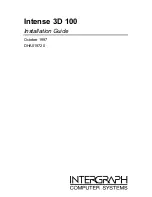
Chapter 1: Introduction
This Serial Communications Card was designed for use in PCI-Bus computers and provides
two serial ports for effective communication in the most common protocols. The card is 6.15
inches long (156 mm) and may be installed in any 5-volt PCI slot in IBM or compatible
computers.
Multi-Protocol Operation
These are dual-protocol serial cards that support RS422 and RS485 communications. RS422
uses differential (or balanced) line drivers to improve noise immunity and increase the
maximum distance to 4000 feet. RS485 improves on RS422 with switchable transceivers and
the ability to support multiple devices on a single "party line". The RS485 specification defines a
maximum of 32 devices on a single line. The number of devices served on a single line can be
expanded by use of "repeaters".
RS485 and RS422 Balanced Mode Operation
The cards support RS422 and RS485 modes which use differential balanced drivers for
increased range and noise immunity. The card also has capability to add bias voltages and to
add load resistors to terminate the communications lines. RS485 communications requires that
one transmitter supply a bias voltage to ensure a known "zero" state when all transmitters are
off. Also, receiver inputs at each end of the network should be terminated to eliminate "ringing".
These cards support these options by means of jumpers on the card. See the "Option
Selection" section of this manual for more details.
COM Port Compatibility
Type 16550 UARTs are used as the Asynchronous Communication Element (ACE). These
include a 16-byte transmit/receive FIFO buffer to protect against lost data in multitasking
operating systems, while maintaining 100% compatibility with the original IBM serial port. PCI
bus architecture allows addresses between 0000 and FFF8 hex to be assigned to the cards.
PCIFind.EXE is a utility provided to determine the base addresses assigned by the system.
A crystal oscillator is located on the card. This oscillator permits selection of baud rates up to
115,200. Rates up to 460,800 baud (4X UART clock) are available by jumper selection.
The driver/receiver used, the 75176, is capable of driving extremely long communication lines
at high baud rates. It can drive up to +60 mA on balanced lines and receive inputs as low as
200 mV differential signal superimposed on common mode noise of +12 V or -7 V. In case of
communication conflict, the driver/receivers feature thermal shutdown.
Communication Modes
The cards support Half-Duplex, and Full-Duplex communications in 2- and 4-wire cable
connections. Half-Duplex allows traffic to travel in both directions, but only one way at a time. In
Full-Duplex operation, data travels in both directions at the same time. RS485 communications
use the half-duplex mode because only a single pair of wires need to be used and installation
costs are dramatically reduced.







































